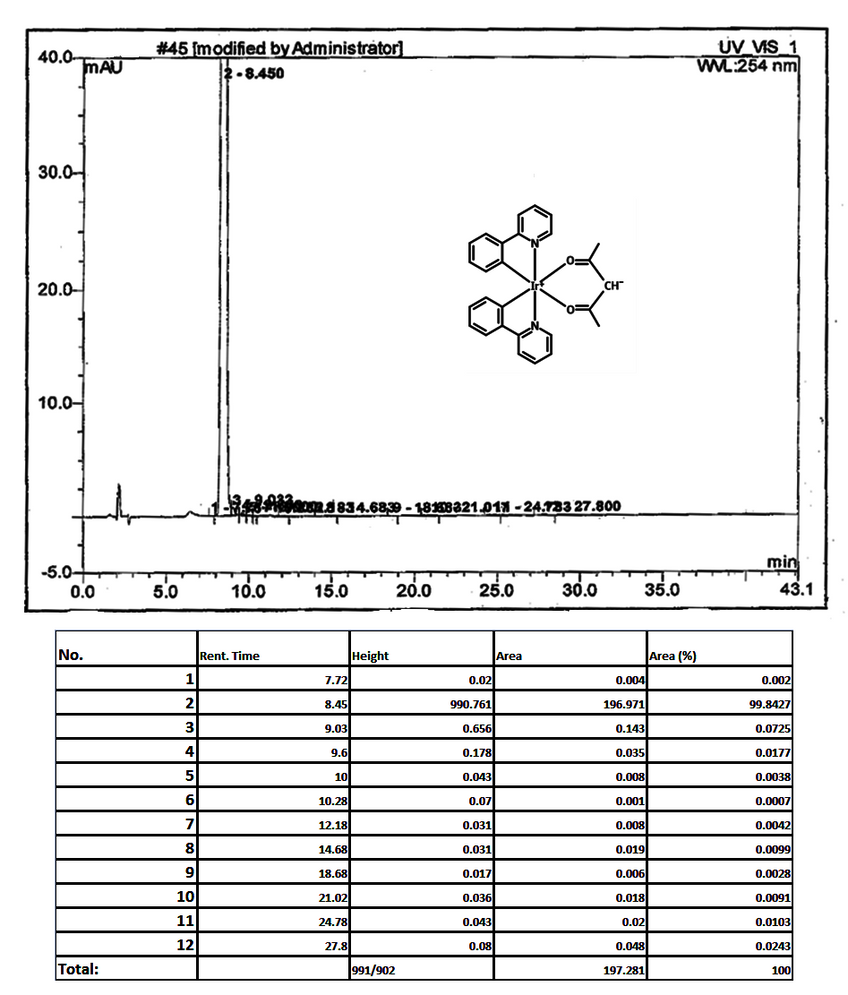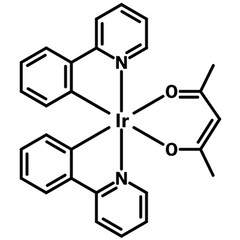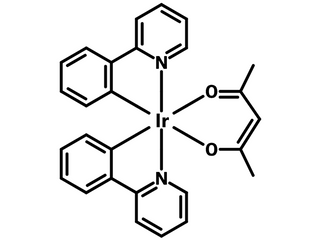Ir(ppy)2(acac)
CAS Number 337526-85-9
Dopant Materials, Green Dopant Materials, High Purity Sublimed Materials, Materials, OLED Materials, Semiconducting MoleculesIr(ppy)2(acac), OLED material with high quantum yields
Higher external quantum efficiency than Ir(ppy)3, Bis[2-(2-pyridinyl-N)phenyl-C](acetylacetonato)iridium(III), CAS No. 337526-85-9, Sublimed ≥99.0%, Unsublimed Sublimed ≥98.0%
Like Ir(ppy)3, bis[2-(2-pyridinyl-N)phenyl-C](acetylacetonato)iridium(III), or Ir(ppy)2(acac), is one of the most studied OLED materials due to its high quantum yields. When doped into 3,5-Diphenyl-4-(1-naphthyl)-1H-1,2,4-triazole (TAZ), very high external quantum efficiencies of (19.06 ± 1.0%) and luminous power efficiencies of 60±5 lm/W were achieved.[1] This was attributed to the nearly 100% internal phosphorescence efficiency of Ir(ppy)2(acac), coupled with balanced hole and electron injection, and triplet exciton confinement within the light-emitting layer.
Ir(ppy)2(acac) demonstrated higher external quantum efficiency when compared with Ir(ppy)3. It was suggested that Ir(ppy)2(acac) molecules preferentially align so that their transition dipole moment is parallel to the substrate, whereas the orientation of Ir(ppy)3 molecules is nearly isotropic.[2]
General Information
| CAS number | 337526-85-9 |
|---|---|
| Chemical formula | C27H23IrN2O2 |
| Molecular weight | 599.70 g/mol |
| Absorption | λmax 259 in THF |
| Fluorescence | λem 314 in THF |
| HOMO/LUMO | HOMO 5.6 eV, LUMO 3.0 eV [1] |
| Synonyms | (ppy)2Ir(acac), Bis[2-(2-pyridinyl-N)phenyl-C](acetylacetonato)iridium(III), Bis[2-(2-pyridinyl-N)phenyl-C](2,4-pentanedionato-O2,O4)iridium(III), Irppy2acac |
| Classification / Family | Organometallic complex, Green emitter, phosphorescence dopant OLEDs, OLED and PLED materials, Sublimed materials |
Product Details
| Purity |
>99.5% (sublimed) >98.0% (unsublimed) |
|---|---|
| Melting point | 349-356 °C |
| Appearance | Yellow powder/crystals |
*Sublimation is a technique used to obtain ultra pure-grade chemicals. For more details about sublimation, please refer to the Sublimed Materials.
Chemical Structure
Device Structure(s)
| Device structure | ITO/MO3 (1 nm)/CBP (35 nm)/8 wt% Ir(ppy)2(acac):CBP/TPBi (65 nm)/LiF/Al (100 nm) [3] |
|---|---|
| Color | Green |
| EQE@100 cd/m2 | 23.4 |
| Current Efficiency@100 cd/m2 | 81 cd/A |
| Power Efficiency@100 cd/m2 | 78.0 lm W−1 |
| Device structure | Cl-ITO*/CBP (35 nm)/CBP:Ir(ppy)2(acac) (15 nm, 8 wt%)/TPBi (65 nm)/LiF (1 nm)/Al (100 nm) [4] |
|---|---|
| Color | Green |
| EQE@100 cd/m2 | 29.1 |
| Current Efficiency@100 cd/m2 | 93 cd/A |
| Power Efficiency@100 cd/m2 | 97 lm W−1 |
| Device structure | ITO (70 nm)/TAPC (30 nm)/TCTA (10 nm)/TCTA:B3PYMPM:Ir(ppy)2(acac) (30 nm, 1:1: 8 wt%)/B3PYMPM (40 nm)/ LiF (0.7 nm)/ Al (100 nm) [6] |
|---|---|
| Color | Green |
| Turn on Voltage | 2.4 V |
| EQE@100 cd/m2 | 29.1 |
| Power Efficiency@100 cd/m2 | 124.0 lm W−1 |
| Device structure | ITO/PEDOT:PSS/α-NPD (20 nm)/TCTA (5 nm)/T2T*:(PPy)2Ir(acac)(9:1 wt%) (25 nm)/TAZ (50 nm)/LiF (0.5 nm)/Al (100 nm) [7] |
|---|---|
| Color | Green |
| Max. Luminance | 85,000 cd/m2 |
| Max. Current Efficiency | 54 cd/A |
| Max. EQE | 17.4% |
| Max. Power Efficiency | 48 lm W−1 |
| Device structure | ITO/PEDOT:PSS (40 nm)/NPB (15 nm)/ TCTA: 4 wt.% Ir(piq)3 (3.5 nm)/TCTA: 4 wt.% Ir(bt)2(acac) (4 nm)/TCTA: 25 wt.% TmPyPb*: 2 wt. % 4P-NPD* (7 nm)/TmPyPb (4 nm)/TmPyPb: 5 wt.% Ir(ppy)2(acac) (3 nm)/TmPyPb (15 nm)/TmPyPb: 4 wt.% Cs2CO3 (35 nm)/ Cs2CO3/Al [8] |
|---|---|
| Color | White |
| EQE@1000 cd/m2 | 14.2% |
| Current Efficiency@1000 cd/m2 | 26 cd/A |
| Power Efficiency@1000 cd/m2 | 21.9 lm W−1 |
| Device structure | ITO/MoO3(1nm)/CBP(20nm)/CBP: Ir(piq)2(acac) (3 wt.%,4 nm)/CBP: Ir(DMP)3(5 wt.%,4 nm)/CBP: Ir(ppy)2(acac)(7 wt.%,5 nm)/CBP(3 nm)/Bepp2:BCzVBi(50wt.%,40nm)/Bepp2(20nm)/LiF(1nm)/Al(100nm) [9] |
|---|---|
| Color | White |
| Max. Current Efficiency | 26.4 cd/A |
| Max. Power Efficiency | 24.8 lm W−1 |
| Device structure | Glass/PEDOT:PSS (100 nm)/TAPC (30 nm)/CBP:8 wt% Ir(ppy)2(acac) (20 nm)/B3PYMPM (25 nm)/B3PYMPM:Rb2CO3 (45 nm)/Al(150 nm) [10] ITO FREE |
|---|---|
| Color | Green |
| Max. EQE | 64.5% |
| Max. Power Efficiency | 283.4 lm W−1 |
| Device structure | ITO/PEDOT:PSS/TCTA (25 nm)//TCTA:8 wt% Ir(ppy)2(acac) (10 nm)/TPBi (150 nm)/LiF (10 nm)/Al (150 nm) [11] |
|---|---|
| Color | Green |
| Max. EQE | 23.7% |
| Max. Current Efficiency | 88 cd/A |
| Max. Power Efficiency | 67.5 lm W−1 |
*For chemical structure information please refer to the cited references.
Characterization

Pricing
| Grade | Order Code | Quantity | Price |
|---|---|---|---|
| Sublimed (>99.5% purity) | M661 | 100 mg | £260 |
| Unsublimed (>98.0% purity) | M662 | 250 mg | £240 |
| Sublimed (>99.5% purity) | M661 | 250 mg | £520 |
| Unsublimed (>98.0% purity) | M662 | 500 mg | £420 |
| Sublimed (>99.5% purity) | M661 | 500 mg | £950 |
| Unsublimed (>98.0% purity) | M662 | 1 g | £760 |
| Sublimed (>99.5% purity) | M661 | 1 g | £1600 |
MSDS Documentation
Literature and Reviews
- Nearly 100% internal phosphorescence efficiency in an organic light-emitting device, C. Adachi et al., J. Appl. Phys. 90, 5048 (2001); http://dx.doi.org/10.1063/1.1409582.
- Comparing the emissive dipole orientation of two similar phosphorescent green emitter molecules in highly efficient organic light-emitting diodes, P. Liehm et al., Appl. Phys. Lett. 101, 253304 (2012); http://dx.doi.org/10.1063/1.4773188.
- Highly simplified phosphorescent organic light emitting diode with >20% external quantum efficiency at >10,000cd/m2, Z. B. Wang et al., Appl. Phys. Lett. 98, 073310 (2011); doi: 10.1063/1.3532844 .

